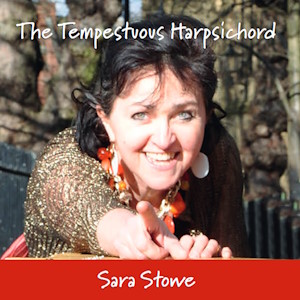
The Tempestuous Harpsichord
Alan Hovhaness (1911-2000)
Dark River, Distant Bell Opus 212 (1964)
Stephen Montague (1943-)
Mirabella
Alan Hovhaness
Bare November Day Opus 210 (1964)
Jenni Pinnock (b. 1987)
Tempestuous
Alan Hovhaness
Sonata for Harpsichord No.1 Opus 306 (1977)
Sara Stowe (harpsichord)
rec. 2023, St Giles’ Bletchingdon, Oxon, UK
Tremula Records TREM702 [48]
The majority of works on this disc are by the American/Armenian composer Alan Hovhaness, who over his long career attracted a dedicated following, but equally had many detractors who were never drawn to his sound world, influenced as it is by non-western scales and the music of other cultures. He also committed the unforgiveable sin of writing so much music – well over 400 opus numbers, not including the, by his count 1000, works he destroyed before he found his chosen style in 1940. Of these, there are at least seventy symphonies the most famous of which is the second, entitled ‘ Mysterious Mountain’ Opus 132(1955) which was taken up by Stokowski (review). My personal favourite is No. 50 ‘Mount Saint Helen’s Opus 360 written in 1982, which graphically captures aurally the devastating eruption of the volcano (review). In the fifties, he wrote a number of works for the choreographer Robert Cohan who told me that “music literally flowed out of him. He would sit down to play the piano and not stop till his fingers were bleeding”. Like Milhaud, a composer criticised for writing too much, he could and did write music anywhere, in an airport, in a café, on a train. No extraneous noise would distract him. Again like Milhaud, not all of his music is brilliant, so comes across are mere note-spinning, but in his vast output there is much worth exploring. He is at his best using large forces where his ear for orchestral colour is most effective.
‘Dark River and Distant Bell’ Opus 212 and ‘Bare November Day’ Opus 210 were written in 1964 after he had returned from study trips to India, Korea, and Japan where he studied Gagaku. The scales and processes of those many cultures colour both of these works. It is perhaps his non-reliance on a Western approach to harpsichord writing that makes these works so intriguing. ‘Dark River and Distant Bell’, with its chant like processional melodies and sudden dissonant harmonies, owes much to Japanese Imperial court music. A particular feature of the work are the long-held chords, so we are able to appreciate the overtones of each note as they collide in space. With ‘Bare November Day’ consisting of a prelude and four hymns, we are back on more familiar structural territory. The scales are non-western but chorale-like writing and simple canonic writing are. In their simplicity of expression, they are perhaps reminiscent of some Elizabethan keyboard works. Both works appeared on a 2021 release played by Nicholas Palmer where a more spacious acoustic allows them to sing more (review).
Hovhaness’s daughter, Jean Nandi (named after her godfather Sibelius), played the harpsichord, though most of her professional life was spent in cancer research, and the composer wrote some though not all of his works for her. The Sonata No 1 (there are seven in total) was written in 1977 and premiered by her in a concert she gave with her father the following year. The whole concert can be heard here.
Dr Nandi plays the work at a generally brisker speed than here; her rendition of the prelude is almost twice the speed of Ms Stowe. In general, her version has a lighter touch to it and brings out the dance like elements more and this seems entirely appropriate to the music.
Stephen Montague is an American-born composer long resident in the U.K. This work ‘Mirabella’ began life as ‘Mira’ a piano work written for ‘Spectrum’ and series of educational piano pieces. Margaret Leng Tan who frequently performs on toy piano heard the work and asked the composer if she could play it on that instrument. With its slow section excised, ‘Mira’ became the dance like ‘Mirabella’ for toy piano and this is its first recording on harpsichord. In this shape, it is a lively tarantella/gigue-like work. It has minimalist overtones with repeated sections and often a lively interplay between 2/4 and 6/8 rhythmic divisions; it is an entertaining addition to the repertoire played with the requisite sense of fun.
‘Tempestuous’ by the young British composer Jenni Pinnock, and from which the album takes its title, the liner notes tell us ’depicts the busy, swirling nature of a storm’. If it does, it is a very jolly storm. The outer sections are in a lively 7 time and fairly dance along; the middle section is calmer and in it Ms Stowe uses the mute stop very effectively. It was originally written for organ, and I do wonder if the greater dynamic range available on that instrument would have permitted it to sound more like a tempest.
In an interview in the 1978 concert, I mention above how Hovhaness talks about his dislike of harpsichord being recorded too closely, as it can distort the true nature of their sound. For this recording, Ms Stowe played on two single manual harpsichords: a 2022 Ruckers copy by Peter Stephens and a 1975 Dennis Woolle. Both are very closely recorded and while they do have very quiet actions which do not distract the listener the sound is very loud, and I doubt whether Mr Hovhaness would have approved.
Paul RW Jackson
Availability: Birnam CD Shop


















